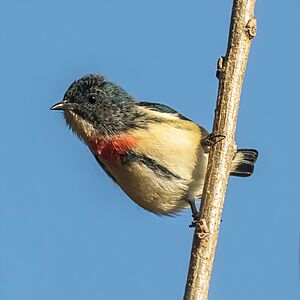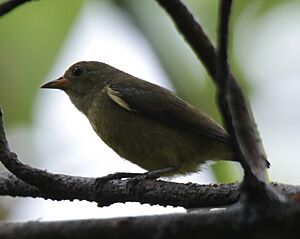Fire-breasted flowerpecker facts for kids
Quick facts for kids Fire-breasted flowerpecker |
|
|---|---|
 |
|
| Male of nominate subspecies from Nepal | |
 |
|
| Female | |
| Conservation status | |
| Scientific classification | |
| Genus: |
Dicaeum
|
| Species: |
ignipectus
|
| Synonyms | |
|
Myzanthe ignipectus |
|
The fire-breasted flowerpecker (Dicaeum ignipectus) is a tiny, colorful bird found in parts of Asia. It belongs to the Dicaeidae family, which includes many small birds that love to eat fruit. These birds are very important because they help spread seeds from fruiting plants, which helps new plants grow. Male fire-breasted flowerpeckers are easy to spot because they have bright colors, especially a fiery orange patch on their chest. Females are usually duller in color.
Contents
What the Fire-breasted Flowerpecker Looks Like
The fire-breasted flowerpecker is a very small bird. It has a small, dark beak.
Male and Female Birds
Male birds have shiny blue-black feathers on their upper parts. Their underside is a light buff color. They have a bright red patch on their chest. Below this red patch, a short black stripe goes down to their belly.
Female birds look different. They are dark olive green on top and buff colored underneath. Their sides are olive green. The base of their beak is a pale color.
Size and Sound
This bird is one of the smallest flowerpeckers. It weighs only 7–9 g (0.25–0.32 oz). It measures less than 7 cm (2.8 in) long.
You can often find them at the very tops of trees. They especially like to be near mistletoe plants. They make a sharp, loud call. Some people say it sounds like scissors snipping. Others describe it as a quick tsit sound.
Where the Fire-breasted Flowerpecker Lives
You can find the fire-breasted flowerpecker in many places. It lives in the Indian Subcontinent and Southeast Asia. This includes countries like India, Nepal, Bhutan, and Bangladesh. It also lives in Indonesia, Laos, Thailand, Vietnam, Taiwan, Malaysia, and the Philippines.
Their Homes in Nature
These birds like to live in different kinds of forests. They prefer temperate forests. They also live in warm, wet lowland forests. You can find them in wet montane forests, which are forests on mountains.
Mountain Homes
Throughout most of its range, this bird lives in high mountains. They are usually found above 1000 meters (about 3,280 feet). However, in China, they sometimes move to lower areas during the winter months.
Behaviour and Life Cycle
Like many other flowerpeckers, these birds help spread seeds. They are especially good at spreading the seeds of mistletoe plants. In the Nepal Himalayas, they are very important for spreading a type of mistletoe called Scurrula.
Nesting and Young Birds
In a place called Nainital, these birds usually build their nests in June and July. Their nest hangs down like a purse. It has an opening on the side near the top.
The nest is thin and feels like felt. It is made from the hairy coverings of mistletoe stems. The inside of the nest is soft, lined with moss and soft grass. The female bird usually lays two or three eggs. Both the male and female birds take turns sitting on the eggs to keep them warm. They both also help take care of the baby birds once they hatch.
In Hong Kong, the number of fire-breasted flowerpeckers has grown. This is because the forests there have grown back and become more mature. They were first seen in Hong Kong in 1954. They have been nesting there regularly since 1975.
Gallery
-
Lithograph by John Gould in the Birds of Asia (1850–83), volume 6, plate 14.
-
Male of nominate race, Nepal.
-
Fire-breasted flowerpecker, Khangchendzonga National Park, Sikkim, India






